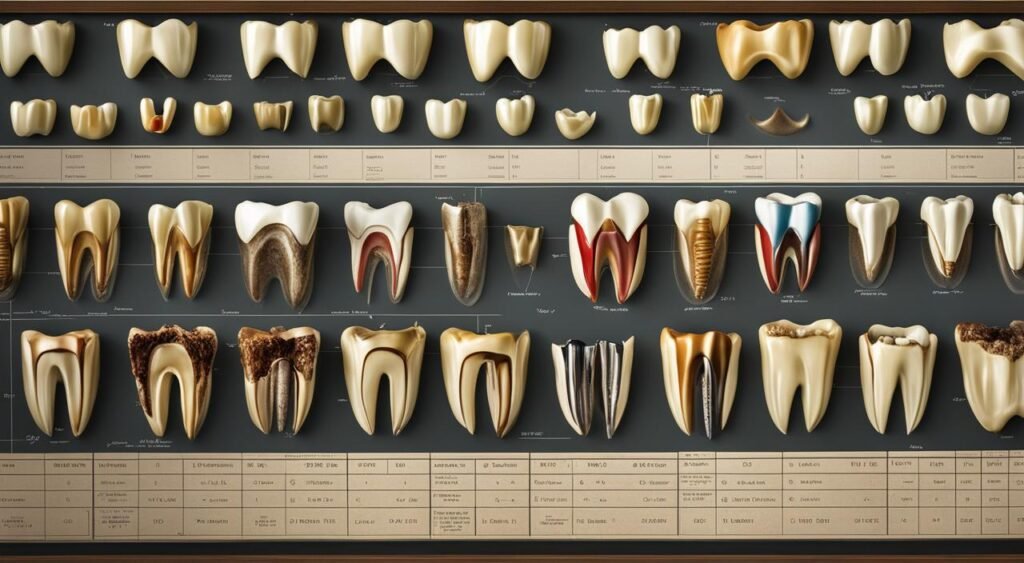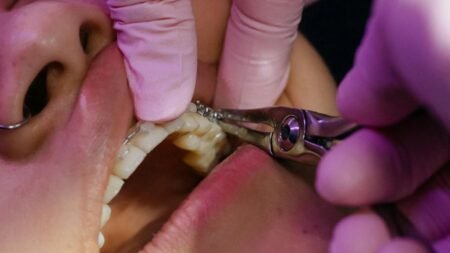Have you ever wondered how dentists keep track of your dental health? Or why they use those mysterious dental charts during your examinations? Well, get ready to unravel the secrets behind dental anatomy and tooth numbering systems, as we delve into the world of teeth charts.
When it comes to maintaining a healthy smile, knowledge is power. By understanding the intricacies of dental charts, you can gain valuable insight into your oral health and play an active role in your dental care.
In this article, we will demystify the dental chart and explore its various components, including the dental anatomy chart, tooth numbering system, and the significance of dental examinations. From deciphering tooth codes to assessing dental health, we will equip you with the knowledge to take charge of your smile.
So, are you ready to discover the secrets within the teeth chart? Let’s embark on this journey together!
The Basics of Dental Anatomy: Deciphering the Teeth Chart
In this section, we will explore the fascinating world of dental anatomy and how it is represented in a teeth chart. Understanding the dental anatomy chart is essential for identifying oral health issues and maintaining optimal dental care.
Dental Anatomy Chart: An Overview
The dental anatomy chart is a visual representation of the structure and composition of teeth. It illustrates the arrangement of different types of teeth and their specific characteristics.
There are two main categories of teeth featured in the dental anatomy chart: permanent and deciduous teeth.
Permanent Teeth Chart
Permanent teeth, also known as adult teeth, are the set of teeth that replace the deciduous teeth. These teeth typically begin to erupt at around six years of age and continue to develop into early adulthood.
The permanent teeth chart consists of four types of teeth:
- Incisors: These are the sharp, narrow teeth located at the front of the mouth. They are used for biting into food.
- Canines: The canines are the pointy teeth situated on each side of the incisors. They assist in tearing and ripping food.
- Premolars: Positioned behind the canines, premolars have flat surfaces that aid in chewing and grinding food.
- Molars: The molars are the largest and strongest teeth found at the back of the mouth. They are responsible for crushing and grinding food.
Here is an example of a permanent teeth chart:
| Tooth Type | Numbering System | Description |
|---|---|---|
| Incisors | 1 – 8 (upper jaw) 9 – 16 (lower jaw) | Sharp, wedge-shaped front teeth |
| Canines | 6 – 11 (upper jaw) 22 – 27 (lower jaw) | Pointy teeth aiding in tearing food |
| Premolars | 4, 5, 12, 13 (upper jaw) 20, 21, 28, 29 (lower jaw) | Flat-surfaced teeth for chewing and grinding |
| Molars | 1, 2, 3 (third molars/wisdom teeth) 14, 15, 16 (upper jaw) 17, 18, 19 (lower jaw) 30, 31, 32 (third molars/wisdom teeth) | Largest teeth responsible for crushing and grinding |
Deciduous Teeth Chart
Deciduous teeth, commonly referred to as baby teeth or milk teeth, are the first set of teeth that erupt in childhood. They eventually fall out to make way for the permanent teeth.
The deciduous teeth chart consists of four types of teeth, similar to the permanent teeth:
- Incisors
- Canines
- Premolars (also known as first molars)
- Molars (also known as second molars)
It is important to note that the deciduous teeth chart has a different numbering system compared to the permanent teeth chart.
Here is an example of a deciduous teeth chart:
| Tooth Type | Numbering System | Description |
|---|---|---|
| Incisors | A – J (upper jaw) K – T (lower jaw) | Front teeth for biting |
| Canines | One letter back from the permanent teeth numbering | Pointed teeth assisting in tearing food |
| Premolars | M (upper jaw) N (lower jaw) | Flat-surfaced teeth for chewing |
| Molars | Two letters back from the permanent teeth numbering | Largest teeth for crushing and grinding |
Understanding the dental anatomy chart, whether it is for permanent or deciduous teeth, can greatly assist in maintaining proper dental records and identifying any potential oral health issues.
Cracking the Code: Decoding Tooth Numbering Systems
In dental examinations, dentists use a tooth numbering system to identify specific teeth and communicate effectively with their patients. Understanding how tooth numbering systems work can empower you to actively participate in your dental health journey and track your progress.
There are various numbering systems utilized in dentistry, with the two most common ones being the Universal Numbering System and the Palmer Notation Method.
The Universal Numbering System
The Universal Numbering System assigns a unique number to each tooth in the mouth, from 1 to 32 for permanent teeth and A to T for primary teeth. This system provides a standardized way for dentists to refer to teeth during examinations, treatments, and discussions with patients.
Here’s a table illustrating the tooth numbering system in the Universal Numbering System:
| Tooth Type | Numbering Scheme (Permanent Teeth) | Numbering Scheme (Primary Teeth) |
|---|---|---|
| Central Incisor | 1, 2 | A, B |
| Lateral Incisor | 2, 3 | B, C |
| Canine | 3, 4 | C, D |
The Palmer Notation Method
The Palmer Notation Method utilizes symbols to represent each quadrant of the mouth and numbers or letters to assign specific teeth within each quadrant. This system offers a visual representation of dental occlusion and allows dentists to easily identify teeth during dental examinations.
Here’s an example of the Palmer Notation Method:
| Tooth Type | Palmer Notation (Permanent Teeth) |
|---|---|
| Central Incisor | 1 |
| Lateral Incisor | 2 |
| Canine | 3 |
By familiarizing yourself with these tooth numbering systems, you can enhance your communication with your dentist and take an active role in monitoring and understanding your dental health.
Next, we will discuss the importance of dental charts in assessing dental health.

Assessing Dental Health: The Importance of Dental Charts
In this section, we will explore the significant role dental charts play in assessing dental health. Dentists utilize dental charts as a comprehensive tool to record and track various aspects of oral health. By gaining a deeper understanding of how dental charts are used, you can actively participate in monitoring and improving your own dental health.
Dental charts serve as a visual representation of your oral health, providing valuable insights into your dental history and ongoing treatments. Dentists use dental charts to accurately document and track important information such as tooth decay, gum disease, and previous dental procedures. By referring to these charts, dentists can create personalized treatment plans and monitor progress over time.
One of the key benefits of dental charts is their ability to aid in early detection and intervention. Regular dental examinations accompanied by chart analysis allow dentists to identify potential oral health issues at their earliest stages. This proactive approach enables timely intervention, preventing further complications and promoting overall dental wellness.
“Dental charts provide a comprehensive overview of a patient’s oral health history, enabling dentists to understand the complete picture and provide individualized care.”
– Dr. Emily Parker, DDS
The Role of Dental Charts in Dental Examinations
During a dental examination, the dentist assesses the overall oral health by examining the teeth, gums, and surrounding tissues. Dental charts are invaluable tools in this process as they provide a detailed record of the patient’s dental health, aiding in the identification of any abnormalities or changes.
With the help of dental charts, dentists can record findings such as tooth decay, gum recession, and signs of periodontal disease. These records provide a benchmark for future examinations and allow dentists to track the progression of any issues or monitor the success of treatments.
Monitoring Dental Health Through Chart Analysis
By carefully analyzing dental charts, dentists can identify patterns, trends, and areas of concern. They can assess the effectiveness of previous treatments and adjust the course of action if necessary. Dental charts also serve as a valuable reference during patient consultations, allowing dentists to visually illustrate the current state of oral health and discuss treatment options in detail.
Regular dental examinations accompanied by thorough chart analysis empower patients to make informed decisions about their oral health. By understanding the information presented in their dental charts, individuals can actively participate in their treatment plans, maintain oral hygiene practices, and strive for optimal dental health.
In the next section, we will provide you with practical tips on maintaining dental health, including the role of regular dental examinations and the significance of tooth charting in tracking your oral well-being.
Keeping Your Smile Radiant: Tips for Maintaining Dental Health
Now that you understand the importance of dental examinations and tooth charting in maintaining optimal dental health, let’s explore some practical tips and strategies that can help you maintain a radiant smile for years to come.
First and foremost, it is crucial to schedule regular dental examinations with your dentist. These examinations allow your dentist to assess your dental health, detect any potential issues early on, and provide necessary treatments. By staying proactive with dental examinations, you can address dental problems before they become serious and ensure the continued health of your teeth and gums.
In addition to regular check-ups, a dental health chart can be a valuable tool in monitoring your dental health at home. By using a tooth charting template, you can track any changes or concerns you may have noticed, such as tooth sensitivity, gum inflammation, or discoloration. This visual record will not only help you communicate effectively with your dentist but also give you a better understanding of your dental health over time.
Lastly, maintaining good oral hygiene practices and making healthy lifestyle choices are key to keeping your smile radiant. Brushing your teeth twice a day, flossing daily, and using mouthwash can significantly reduce the risk of tooth decay and gum disease. Avoiding tobacco products, limiting sugary and acidic food and drink, and staying hydrated promote overall oral health as well.
In conclusion, a combination of regular dental examinations, tooth charting, proper oral hygiene practices, and healthy lifestyle choices is essential for maintaining optimal dental health. By incorporating these tips into your daily routine, you can ensure a radiant and healthy smile that lasts a lifetime.
FAQ
What is a teeth chart?
A teeth chart, also known as a dental chart or dental anatomy chart, is a visual representation of the teeth and their corresponding identifying numbers. It provides a systematic way for dentists to identify and record specific teeth during examinations and maintain accurate dental records.
How is a tooth numbering system used in dental examinations?
A tooth numbering system, such as the Universal Numbering System or the Palmer Notation Method, is used by dentists to identify and refer to specific teeth during examinations. This helps dentists communicate efficiently and track the location and condition of each tooth in a patient’s mouth.
What is the difference between permanent and deciduous teeth?
Permanent teeth, also known as adult teeth, are the set of teeth that replace the primary or deciduous teeth. Deciduous teeth, commonly referred to as baby teeth, are the first set of teeth that appear during infancy and are eventually replaced by permanent teeth as a child grows.
How do dental charts help in assessing dental health?
Dental charts play a crucial role in assessing dental health by recording and tracking various aspects of oral health, including tooth decay, gum disease, and dental treatments. By referring to dental charts, dentists can monitor changes in a patient’s dental health over time and make informed treatment decisions.
How can tooth charting and dental examinations help in maintaining dental health?
Tooth charting and regular dental examinations are essential for maintaining dental health. Tooth charting helps track the condition and treatment history of each tooth, while dental examinations enable dentists to identify and address potential dental issues, such as cavities or gum disease, before they worsen. Regular dental check-ups and proper oral hygiene practices are key to preventing dental problems and ensuring a healthy smile.









1 Comment
Pingback: Teeth Falling Out Dream: A Spiritual Guide in 2024